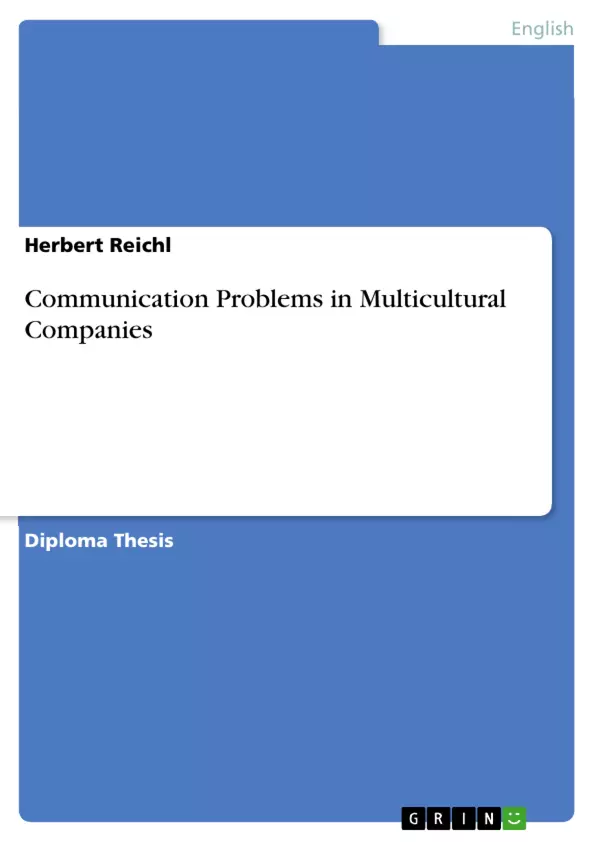Although I have never been a regular viewer of ‘Star Trek’ and thus would not con¬sider myself a “Trekkie”, I have chosen this quotation as a starting point as it very well ex¬presses the problem I will deal with in the following paper: being different in terms of culture, language, education, or social status.
I have also chosen the above quotation because of its second line as it suggests a produc¬tive way of dealing with the difficulty of being different. Be it in a thousand years or in the present time, we have to find solutions to the problems that arise when people coming from totally different cultural or social backgrounds meet and have to live together.
In the course of my studies at the University of Salzburg, I have come across a broad variety of topics related to the field of Linguistics. Among others, I dealt with the linguistic terminology at the beginning of our studies, some varieties of English, their main features, with Psycholinguistics, or with language acquisition but to name a few. However, one main topic of Linguistics that has always had a special attraction to me was the field of Sociolin-guistics. It has been interesting to hear how speakers’ cultural or social background, age, gen-der, or education, have an influence on their register. Furthermore, it is also important that language always represents a certain status or the membership to a certain ethnic group and/or minority. Normally, people who speak a certain dialect are proud of that and it means more to them than just speaking it. It represents heritage, tradition, and sometimes nationalism for them. They simply want to be different in order to dissociate themselves from other ethnic groups with different dialects.
Inhaltsverzeichnis (Table of Contents)
- Part One: Definitions And Basic Concepts
- 1) Introduction
- 2) Towards A Clear Definition Of The Terms “Intercultural“ And “Multicultural“
- 3) Intercultural Encounters - Not A New Phenomenon
- 4) What Is Culture?
- 5) From Language To Intercultural Communication
- 6) Hofstede's Dimensions Of Cultural Variability
- 7) The Relationship Between Culture And Language
- 8) Summary And Outlook On Part Two
- Part Two: Practical Concepts In Use
- 9) Applying Hofstede's Dimensions
- 10) Other Cultural Dimensions
- 11) Nonverbal Communication
- 12) Values, Norms And Rules
- 13) Generalizations And Stereotypes
- 14) Summary And Outlook On Part Three
- Part Three: Intercultural Difficulties At Work
- 15) Mexico And The USA
- 16) A Comparative Study
- 17) Two More Letters
- 18) Denmark And Germany
- 19) Summary And Outlook On Part Four
- Part Four: Prevention Of Intercultural Problems At Work
- 20) The Need For A Functioning Communication In MNOS
- 21) The Development Of Intercultural Competence
- 22) The Selection Of Suitable Employees
- 23) The Selection Of Employees At The Example Of Siemens
- 24) The Preparation Of Selected Candidates
- 25) The Preparation Of Employees At The Example Of Henkel
- 26) Preparation In Switzerland – ITES
Zielsetzung und Themenschwerpunkte (Objectives and Key Themes)
This paper aims to explore the challenges of intercultural communication within multinational companies. It seeks to provide a sociolinguistic framework for understanding and addressing these challenges, offering practical insights for both management and employees. The paper will analyze the impact of cultural differences on communication and cooperation, exploring potential sources of friction and providing strategies for improving communication and fostering a more harmonious working environment.
- The definition and distinction between “intercultural” and “multicultural”
- The impact of cultural differences on communication and cooperation
- The role of language and nonverbal communication in intercultural encounters
- Strategies for preventing and addressing intercultural problems in the workplace
- The development of intercultural competence for employees
Zusammenfassung der Kapitel (Chapter Summaries)
- Part One: Definitions And Basic Concepts provides a foundational understanding of key terms and concepts related to intercultural communication. It delves into the differences between “intercultural” and “multicultural”, examines the concept of culture itself, and explores the link between culture and language. This section also introduces Hofstede's Dimensions of Cultural Variability, a framework for understanding cultural differences.
- Part Two: Practical Concepts In Use expands on the theoretical framework established in Part One, applying Hofstede's dimensions and exploring other cultural dimensions that influence communication. This section also examines the role of nonverbal communication, values, norms, and the dangers of generalizations and stereotypes in intercultural contexts.
- Part Three: Intercultural Difficulties At Work delves into real-world examples of intercultural communication challenges in multinational companies. Through case studies, the author showcases the practical implications of cultural differences on communication and cooperation, highlighting specific issues and potential solutions.
- Part Four: Prevention Of Intercultural Problems At Work focuses on strategies for mitigating intercultural problems in the workplace. This section explores the need for effective communication in multinational organizations (MNOs) and discusses the development of intercultural competence for employees. It also examines the importance of employee selection and preparation in fostering a positive intercultural working environment.
Schlüsselwörter (Keywords)
This work focuses on intercultural communication within multinational companies, exploring themes such as cultural differences, language barriers, nonverbal communication, values, norms, stereotypes, and the development of intercultural competence. Key concepts include Hofstede's Dimensions of Cultural Variability, intercultural encounters, and strategies for fostering effective communication and collaboration in diverse workplace settings.
- Quote paper
- Herbert Reichl (Author), 2002, Communication Problems in Multicultural Companies, Munich, GRIN Verlag, https://www.hausarbeiten.de/document/10330


